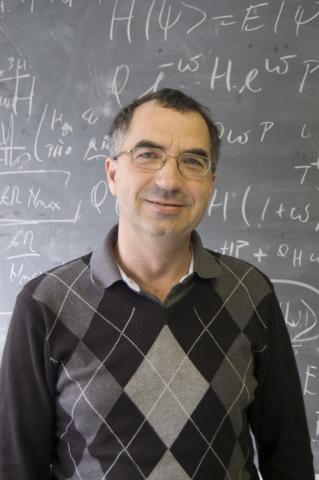
Dr. Petr Navratil, TRIUMF research scientist and leader of the Theory Group, has been elected as a Fellow of the American Physical Society. This prestigious honour is bestowed upon APS members who have made significant advances in physics through original research and publication or innovative contributions in the application of physics to science and technology. Navratil was cited by the APS Division of Nuclear Physics for his “seminal contributions to the development of ab initio nuclear structure and nuclear reaction theory, including pioneering demonstrations of the critical role of realistic three-nucleon reactions.”
“Dr. Navratil’s research is highly recognized internationally, and he is playing a central role in establishing TRIUMF as a world-leading centre for theoretical nuclear physics,” comments Dr. Reiner Kruecken, head of TRIUMF’s Science Division. “We are very proud of his well-deserved recognition.”
Election as a Fellow is a particularly meaningful acknowledgment because it depends solely on nomination and selection by one’s professional peers. Each year, no more than 0.5% of the Society’s 50 000 members are chosen for election. Navratil is one of only five Canadian physicists elected as APS members this year, which also includes Drs. Jimmy Feng of UBC, Josef Paldef from University of Waterloo, David Rosner of the University of Western Ontario, and Alejandro Rey of McGill University.
Dr. Navratil joined TRIUMF in 2010, after working as a research scientist at Lawrence Livermore National Laboratory in California for more than 10 years. He was attracted to TRIUMF because of the close connections between his theoretical calculations and the experiments underway in ISAC-I and II.
“Low-energy nuclear physics is having a Renaissance of sorts,” he explains. “Increasingly, nuclear physicists are able to do precision calculations – so our theoretical predictions of the properties of nuclei can now be tested in the laboratory. This is a new feature which makes the field exciting.”
Navratil’s research focuses on ab initio nuclear structure and reactions theory – in simple terms, examining the fundamental interactions between nucleons (protons or neutrons) in order to calculate and describe properties of the nucleus, using quantum mechanics. Nucleons are not fundamental particles- rather, they are composed of quarks, antiquarks, and gluons, and their complicated structure makes the interactions between them very complex. As a result, many-nucleon calculations that use these interactions require advanced computation techniques, making ab initio nuclear theory one of the most computationally-intensive fields of science. Navratil has made significant contributions to the development of new models and techniques to improve the accuracy of these calculations.
Currently, Navratil is working on a unified approach to nuclear structure and reactions, developing many-body calculations that can simultaneously describe bound and unbound (reacting) states of nuclei. He has also made significant advances in the understanding of three-nucleon forces (interactions which, due to the structure of the nucleons, can not be subdivided into sums of two-nucleon interactions). For example, Navratil was part of a team of collaborators which demonstrated the importance of three-nucleon forces in explaining the long lifetime of Carbon-14, which is used in archeology for carbon dating.
Navratil’s enthusiasm, expertise, and leadership make him a great asset to the laboratory and an outstanding scientist. Congratulations, Petr!
-Lindsay Kroes, Communications Assistant
